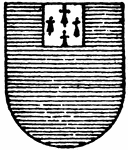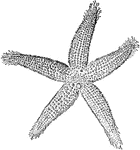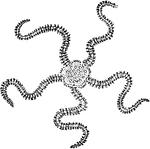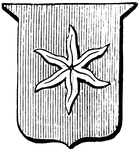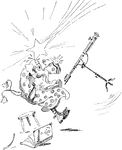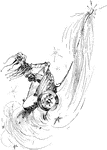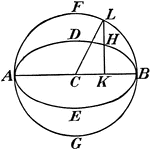
Eccentric Angle
"In geometry, an angle connected with an ellipse and defined as ... angle BCL, reckoned from one determinate…
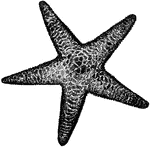
Spiny Sea Star
The Spiny Sea Star (Echinaster sentus) is an echinoderm in the Asteroidea class of starfish.
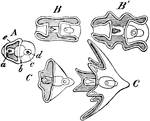
Echinopaedia
Echinopaedia is the name for the early or larval stages of echinoderms like sea stars and sea urchins.…
Common Hydrometer
A hydrometer is an instrument used to measure the specific gravity (or relative density) of liquids;…
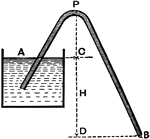
Siphon
A siphon (also spelled syphon) is a continuous tube that allows liquid to drain from a reservoir through…
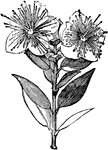
Myrtle
The Myrtle (Myrtus) is a genus of one or two species of flowering plants in the family Myrtaceae, native…
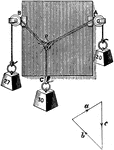
Polygon of Forces
"In the apparatus shown... three forces act on a small body and are allowed to assume a position of…
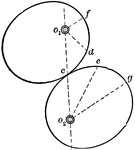
Rolling of Non-cylindrical Surfaces
Illustration showing that the rolling of non-cylindrical surfaces. "If the angular velocity ratio of…

Encephalon
"Diagram of Vertebrate Encephalon ... in longitudinal vertical section. Mb, mid-brain; in front of it…
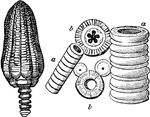
Encrinite
"Encrinite: head and piece of stem. Any fossil crinoid; a stone-lily: a term especially applied to the…

Encrinite
"Encrinite: Any fossil crinoid; a stone-lily: a term especially applied to the ordinary stalked form…

Epicycloid
"In geometry, a curve generated by the motion of a point on the circumference of a circle which rolls…

Potentiometer
A potentiometer instrument for measuring the potential (or voltage) in a circuit taps off a fraction…
!["The Metre Bridge is employed - a piece of apparatus which is illustrated [here]. It consists of a wooden base, upon the upper face of which is mounted a metallic rectangle; three sides of this rectangle are formed by a broad substantial copper band - having a negligible resistance - and the fourth consists of a platinum silver wire w w joining the copper blocks P and p. This wire is exactly one meter long, and over it slides a key K, which when depressed makes contact by means of a platinum knife-edge with the wire; the exact point on the wire at which this contact is made is indicated by an arrow-head on the key, which slides against a scale, as shown." (Britannica, 1891)](https://etc.usf.edu/clipart/61300/61365/61365_metre-bridge_mth.gif)
Metre Bridge
"The Metre Bridge is employed - a piece of apparatus which is illustrated [here]. It consists of a wooden…
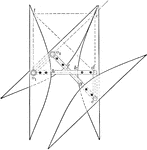
Rolling of Equal Hyperbolas
Illustration of the rolling of equal hyperbolas. If two equal hyperbolas are placed so that the distances…

Cuttlebone
Cuttlefish "bone" or internal shell. The fine point at the base structure represents the guard of the…

Perpendicular To Straight Line Construction
Illustration used to show how to draw a perpendicular to a straight line from a given point on the line…
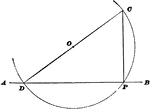
Perpendicular To Straight Line Construction
Illustration used to show how to draw a perpendicular to a straight line from a given point on the line…
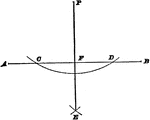
Perpendicular To Straight Line Construction
Illustration used to show how to draw a perpendicular to a straight line from a given point that is…
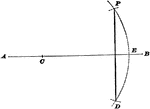
Perpendicular To Straight Line Construction
Illustration used to show how to draw a perpendicular to a straight line from a given point that is…

Parallel To Straight Line Construction
Illustration used to show how to draw a straight line parallel to a straight line through a given point.

Construction Of Angle On Straight Line
Illustration used to show how to "draw a straight line through any given point on a given straight line…

Line Perpendicular To Plane
"If a straight line is perpendicular to each of two straight lines at their point of intersection it…

Plane Perpendicular To Line
"All the perpendiculars to a straight line at the same point lie in a plane perpendicular to the line."

Perpendicular To Line In Plane
"If from the foot of a perpendicular to a plane a straight line is drawn at right angles to any line…

Falcon Bill
"Falcon-bill of about 1450. A form of martel-de-fer, distinguished by its slightly curved and sharp…

Medieval Helmet with Fan Crest
"Fan-crest, about 1350. A form of crest common in the middle ages at different periods, as in the reign…
Siccar Point, Berwick, Scotland
Unconformity at Siccar Point, Berwick, Scotland. Folded and truncated Siluro-Ordovician beds and Old…

Man with Lever and Fulcrum
"In mechanics, the point of rest about which a lever turns in lifting a body; also, a prop or support…
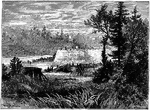
Fort Duquesne
Fort Duquesne (originally called Fort Du Quesne) was a fort established by the French in 1754, at the…
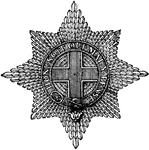
Order of the Garter Star
The star of the Order of the Garter. "Order of the Garter, the highest order of knighthood in Great…

View of Lintz
A picturesque view of the Lintz (Linz) city center. Lintz was founded by the Romans, who called it "Lentia."…
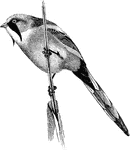
Reed Pheasant
"Panurus biarmicus, the "Bearded Tit" or "Reed-Pheasant" plumage is orange-brown above, with grey crown…

A Still Showing the Separation of a Liquid from a Solid
"Figure 5 shows a form of the apparatus for separating a liquid from another of different boiling point,…
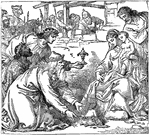
Wise Men of the East Presenting Their Gifts
"And when they were come into the house, they saw the young child with Mary his mother, and fell down,…
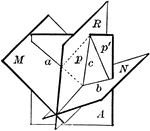
Plane Bisecting Dihedral Angle
Diagram used to prove the theorem: "Every point in a plane which bisects a dihedral angle is equidistant…
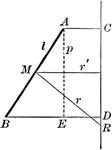
Area of Surface Generated by a Straight Line
Diagram used to prove the theorem: "The area of the surface generated by a straight line revolving about…

Mullet Difference
"Third Son, the MULLET. The differences used by armorists at the present time are nine in number. They…

Definition of Ellipse
Diagram of an ellipse that can used to illustrate the definition. "The constant ration between the distances…

Parts of Ellipse
Diagram of an ellipse that can used to illustrate the different parts. Segment MN is the major axis,…
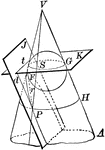
Cone Intersected by a Plane to Form a Parabola
Diagram of a cone intersected by plane J to form a parabola. Also pictured is a circle formed by the…

Foci Distances on an Ellipse
Diagram that illustrates "The algebraic sum of the distances of any point from the foci of a conic is…
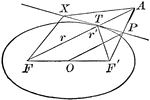
Tangent to an Ellipse
Diagram an ellipse with a tangent line that illustrates "A line through a point on the ellipse and bisecting…
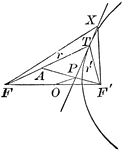
Tangent to a Hyperbola
Diagram part of a hyperbola with a tangent line that illustrates "A line through a point on the hyperbola…

Non-Vocal Primary Point Consonant
Consonants have a closed or narrowly expanded adjustment of the vocal organs, so that in their production…

Non-Vocal Mixed Point Consonant
Consonants have a closed or narrowly expanded adjustment of the vocal organs, so that in their production…

Non-Vocal Divided Point Consonant
Consonants have a closed or narrowly expanded adjustment of the vocal organs, so that in their production…
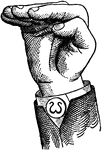
Non-Vocal Mixed-Divided Point Consonant
Consonants have a closed or narrowly expanded adjustment of the vocal organs, so that in their production…

Non-Vocal Shut Point Consonant
Consonants have a closed or narrowly expanded adjustment of the vocal organs, so that in their production…

Non-Vocal Nasal Point Consonant
Consonants have a closed or narrowly expanded adjustment of the vocal organs, so that in their production…

Vocalized Primary Point Consonant
Consonants have a closed or narrowly expanded adjustment of the vocal organs, so that in their production…

Vocalized Mixed Point Consonant
Consonants have a closed or narrowly expanded adjustment of the vocal organs, so that in their production…
